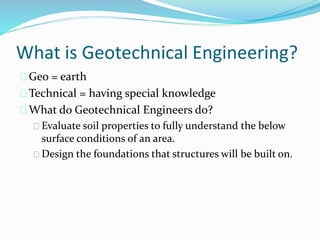Top Guidelines Of Geotheta
Top Guidelines Of Geotheta
Blog Article
The Buzz on Geotheta
Table of ContentsGeotheta - An OverviewHow Geotheta can Save You Time, Stress, and Money.The Ultimate Guide To GeothetaThe Definitive Guide to Geotheta
They work together with civil designers, structural engineers, engineers, and various other specialists to integrate geotechnical considerations into the total job style and building process. This needs effective synergy, control, and communication to ensure that the geotechnical elements align with the task goals and fulfill governing demands.Mining & Products Design: Concepts of boring, penetration rates, and elements influencing the option of boring method. Features of nitroglycerins, shooting systems and blast patterns. Blasting methods in surface area and underground operations. Special blasting strategies at excavation borders. Vibration and noise control. Mechanical and constant methods to fragmentation, consisting of longwall shearing and fullface boring.
Modelling of fragment and fragment dimension circulations; comminution as a transfer feature. Comminution innovation: crushing, grinding, dimension category. Integrated evaluation of fragmentation and comminution operations. Used by: Mining & Products Engineering.
More About Geotheta
Bachelor's level programs in civil, geotechnical, geological, and environmental design usually last four years and include general education programs in English, social science, and the humanities, in addition to courses in sophisticated mathematics, structural geology, and fluid mineralogy. (https://www.mixcloud.com/geotheta/)
Geotechnical design involves the analysis of the dirt and rock problems at a certain website, and their effects for the growth of that site. As many structures depend on the ground for assistance, it is without surprise that an in-depth understanding of the ground problems, and the viability of structure systems, are vital to the long-lasting stability and efficiency of the structure or structure.
Specialising in the examination of geological formations and ground practices, geotechnical designers perform scientific examinations and screening to understand the impact these geological formations might carry the layout and building and construction of structure, civil and infrastructure projects. This expertise is crucial for the style and building and construction of buildings, roads, tunnels, dams, bridges, and water and sewer systems.
The geotechnical group at Douglas Partners consistently seek advice from architects, layout engineers, developers, and builders to make suggestions on design and development propositions to make certain that the constructed structures are appropriately developed for the ground conditions. The style of footing systems requires to consider the weight of the structure, the capacity of the ground to sustain that weight with each other with activity tolerances and effective construction.
Not known Facts About Geotheta
This job is substantially streamlined by the use of our Douglas Map geospatial system that makes this details conveniently accessible in an easy to utilize internet internet browser user interface. A geotechnical engineer will direct the drilling of boreholes and examination pits to collect dirt and other examples, and also examine surface area features and ground exposures to create a geotechnical version of the subsurface conditions.
Relying on the task kind and ground problems came across, laboratory screening might to name a few things assess stamina, compressibility, reactivity and/or permeability of dirt and rock samples. After this data is gathered and looked at, the results are utilized for a geotechnical version of the website, which is normally presented as areas across the website.

A geotechnical investigation naturally can only evaluate the ground problems at the places drilled or dug deep into. Natural variants in dirt and rock problems can take place across a site and between test places. It is as a result excellent practice that the geotechnical engineer be preserved throughout construction of the job to give on-site confirmation that the ground problems encountered are constant with the expectations and guidance given in the geotechnical investigation record.
Geotheta Can Be Fun For Anyone
Geotechnical engineers utilize their thorough understanding of dirt and rock to assess risk and resolve problems on diverse framework projectsGeotechnical design is a specialist branch of civil engineering which checks out the practices of planet materials and the application of dirt and rock auto mechanics. Consulting Engineers. As a geotechnical engineer, you will certainly examine the physical, mechanical and chemical buildings of soil and rock in order to develop structures, maintaining Discover More frameworks and earthworks
Geotechnical design is carefully connected to and overlaps with, both engineering geology and ground design - https://triberr.com/geotheta. It's feasible to be experts in geotechnics or benefit a geotechnical company but be called a design geologist or a ground engineer. As a geotechnical designer, you'll need to: construct and preserve connections with customers and other professionals associated with the website, throughout each projectmaintain security criteria on site bear in mind expense implications when you make recommendationsstudy geological maps and airborne photographs from a range of resources and from different time periodsexamine building plans to see how feasible they are based on your understanding of the siteinvestigate risks or geological threats for the sitesearch for ecologically delicate functions, such as landfill begin to create valid and interpretive ground modelsplan field investigationsdrill and evaluate samples of bedrock, soil, groundwater and added materials manage various other experts on sitesolve technical problems as they occur, such as unforeseen structures at drill sitesmonitor conditions during and after construction to make certain structures are steady in the brief and lengthy termadding data accumulated on site to your preliminary researchcreating geotechnical calculations, illustrations, and two or three-dimensional computer models translating the datamaking suggestions about the suggested use of the site

Report this page